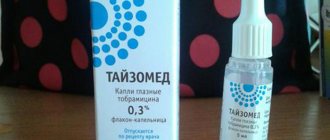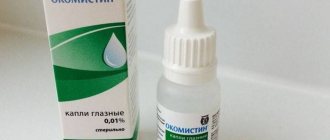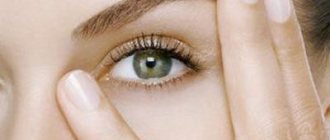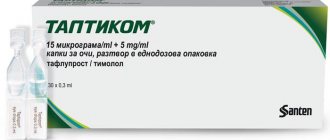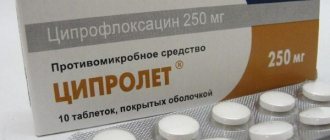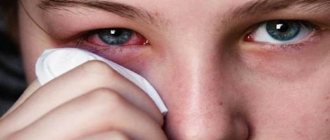Indications
The instructions for Trusopt eye drops indicate that they are used for treatment in adults:
- ocular hypertension;
- primary open-angle glaucoma;
- pseudoexfoliative glaucoma;
- secondary glaucoma.
In children, when taken, glaucoma in infants who are more than 1 week old is cured.
Rules of application
The instructions for Trusopt eye drops recommend the following:
- Before using the drug, you should ensure that the protective strip on the outside of the bottle is intact. For new containers, a gap is allowed between the cap and the neck.
- Removing the protective strip and opening the cap.
- The cap should be turned in the direction indicated by the arrow on its surface. There is no need to pull it up from the bottle.
- Tilt your head back and slightly pull your lower eyelid until there is a space between the eyelid and the eyeball.
- Turn the bottle over, pressing it with two fingers so that a drop gets into the eye. The tip of the bottle should not touch the eyelid or eye, since if used incorrectly, eye pathogens can be introduced, which can lead to serious consequences, including loss of vision. If you suspect an infection has developed, you should immediately contact your doctor.
- If instillation is difficult after the first opening, the bottle must be closed and opened again, following the direction of the arrows on the cap.
- Repeat steps 4 and 5 for the second eye.
- Close the cap until it comes into contact with the bottle. Do not twist it too much to avoid damaging the cap or the bottle itself.
- The dispensing opening of the tip should not be enlarged by yourself.
Trusopt®
When using Trusopt®, the usual dose is 1 drop in the affected eye (or both eyes) in the morning, afternoon and evening.
When replacing any antiglaucoma drug with Trusopt®, treatment with Trusopt should be started from the next day after discontinuation of the previous drug.
When using Trusopt® with other eye drops simultaneously, they should be instilled at intervals of at least 10 minutes.
Rules for using the drug
1. Before using the drug for the first time, you must make sure that the protective strip on the outside of the bottle is not damaged. Unopened bottles may have a gap between the bottle and the cap.
2. Remove the protective strip to open the cap.
3. To open the bottle, you need to unscrew the cap by turning it in the direction of the index arrows on the top surface of the cap. Do not pull the cap upwards away from the bottle.
4. Tilt your head back and slightly pull the lower eyelid down to create a space between the eyelid and the eye.
5. Turn the bottle over and lightly press with your thumb or forefinger in the place specially marked on the bottle so that one drop gets into the eye. Do not touch the surface of the eye or eyelid with the tip of the bottle.
If used incorrectly, ophthalmic medications can become infected with common bacteria that cause eye diseases. Severe eye damage and subsequent vision loss may occur due to the use of contaminated ophthalmic medications. If you suspect that the drug may be contaminated or if an eye infection develops, you should immediately contact your doctor about further use of the bottle.
6. If applying drops is difficult after first opening the bottle, you should place the cap back on the bottle and screw the cap on (not very tightly), then unscrew the cap by turning it in the direction of the index arrows on the top surface of the cap.
7. Repeat steps 4 and 5 for the other eye if the drug should be instilled into both eyes.
8. Close the bottle with the cap, screwing it until it comes into tight contact with the bottle. For proper closure, the arrow on the bottle cap must align with the arrow on the bottle label. Do not tighten the cap too tightly, otherwise you may damage the bottle or cap.
9. The opening of the specially designed pipetting tip should not be enlarged.
Side effects
The instructions for Trusopt eye drops state that during clinical trials they were prescribed to more than 1,000 patients. Side effects from the eyelids and conjunctivitis could be observed in approximately 3% of patients.
Classification of side effects by frequency:
- rare ≥1/10000, <1/1000;
- uncommon ≥1/1000, <1/100;
- frequent ≥1/100, <1/10;
- very common >1/10.
Side effects from the nervous system: quite often - headaches, rarely - dizziness, paresthesia.
Side effects for the visual organs:
- pain and burning occur most often;
- blurred vision, pinpoint superficial keratitis, lacrimation, irritation of the eyelid, conjunctivitis, itching, inflammation of the eyelids are often observed;
- iridocyclitis occurs infrequently;
- rarely - detachment of the choroidal ocular membrane after surgery aimed at restoring the outflow of intraocular fluid, redness of the eyes, decreased intraocular pressure, pain, corneal edema, eyelid hyperkeratosis, corneal edema, transient myopia (disappears after discontinuation of the drug).
Side effects of the respiratory system include nosebleeds and pharyngitis. This is indicated by the instructions for Trusopt eye drops.
From the gastrointestinal tract: often - nausea, bitter taste in the mouth, rarely - dry mouth.
From the mucous membranes and skin: rarely - contact dermatitis, toxic epidermal necrolysis, and Stevens-Johnson syndrome.
Urinary tract side effects occur rarely in the form of urolithiasis.
Allergic reactions are rare and are manifested by systemic and local allergic reactions, which include angioedema, there may also be difficulty breathing, urticaria, rash and itching, and less commonly bronchospasm occurs.
In general, the body often experiences fatigue and asthenia.
Trusopt eye drops 20 mg/ml, 5 ml
In clinical studies, Trusopt was administered to 1,108 patients as monotherapy or add-on therapy to beta-blocker treatment. In approximately 3% of patients, the drug was discontinued due to local ocular adverse reactions, the most common being conjunctivitis and eyelid reactions.
Side effects recorded during studies and during the post-registration period are classified by frequency: very common (>1/10), common (≥1/100,
From the nervous system: often - headache; rarely - dizziness, paresthesia.
From the organ of vision: very often - burning and pain; often - superficial punctate keratitis, lacrimation, conjunctivitis, inflammation of the eyelids, itching, irritation of the eyelid, blurred vision; uncommon - iridocyclitis; rarely - redness of the eyes, pain, hyperkeratosis of the eyelids, transient myopia (disappearing after discontinuation of the drug), corneal edema, decreased intraocular pressure, detachment of the choroidal membrane of the eye after surgical interventions to restore the outflow of intraocular fluid.
From the respiratory system: rarely - nosebleeds, pharyngitis.
From the digestive system: often - nausea, bitter taste in the mouth; rarely - dry mouth.
From the skin and mucous membranes: rarely - contact dermatitis, Stevens-Johnson syndrome and toxic epidermal necrolysis.
From the urinary tract: rarely - urolithiasis.
Allergic reactions: rarely - signs and symptoms of local reactions (from the eyelids) and systemic allergic reactions, including angioedema, urticaria, itching, rash, difficulty breathing, less commonly - bronchospasm.
From the body as a whole: often - asthenia, fatigue.
Children
In a 3-month, double-blind, multicenter, active-control study in 184 children under 6 years of age, the adverse reaction profile of Trusopt was comparable to that observed in adult patients. The most common adverse reactions associated with the use of Trusopt® in children under 2 years of age were conjunctival injection (5.4%) and ocular discharge (3.6%). In children aged 2 to 6 years, the most common adverse reactions were burning sensation in the eye (12.1%), conjunctival injection (7.6%), eye pain (3%), eyelid inflammation (3%).
Overdose
Among the common symptoms: manifestations of disturbed electrolyte balance, metabolic acidosis develops, drowsiness, weakness, nausea, headache, dizziness, unusual dreams, dysphagia.
During treatment, it is necessary to control the concentration of electrolytes in the blood plasma, especially potassium, and control the blood pH. In case of overdose, symptomatic therapy is prescribed.
Drug interactions
There have been no studies on how Trusopt glaucoma drops interact with other medications. However, during clinical trials it was prescribed in combination with other drugs and no inter-drug negative effects were identified, including with Betaxolol and Timolol eye drops. The drug was also used with other systemic drugs: calcium channel blockers, ACE inhibitors, diuretics, NSAIDs (including acetylsalicylic acid), hormones (thyroxine, estrogen, insulin).
There is a possibility of mutual enhancement of the drug "Trusopt" and carbonic anhydrase inhibitors taken orally. Their combined effects have not been studied in clinical trials.
Although the drug "Trusopt" is used topically, it can be absorbed, which sometimes has a systemic effect.
During clinical studies of the use of the drug "Trusopt", no changes in the acid-base balance were detected. However, when using other carbonic anhydrase inhibitors, toxicity was observed when taking high doses of salicylates, so Trusopt should be prescribed with caution in combination with drugs of this group.
The doctor should ask the patient about all medications he or she is taking, including those taken without a prescription.
Particular attention should be paid to taking large doses of acetylsalicylic acid.
TRUSOPT: DOSAGE
The dosage regimen and course duration are determined individually. The patient should not independently change the doses prescribed by the doctor. If the patient stops using the drug, he should immediately consult a doctor for advice.
When used as monotherapy, Trusopt is prescribed 1 drop into the affected eye (or both eyes) 3 times a day (morning, afternoon and evening).
If to reduce intraocular pressure it is necessary to use Trusopt in combination with eye drops belonging to the group of beta-blockers, then Trusopt is prescribed 1 drop into the affected eye (or both eyes) 2 times a day (morning and evening). The interval between instillation of Trusopt and other eye drops should be at least 10 minutes.
To avoid infection, do not allow the tip of the vial to come into contact with the eye, the tissue surrounding the eye, or any surfaces.
If you accidentally miss one dose, instill the solution as quickly as possible. However, if it is time for the next dose, it is recommended to resume the usual regimen without instilling the missed dose.
Instructions for use
1. Before using the drug for the first time, you must make sure that the protective strip on the outside of the bottle is not damaged. Unopened bottles may have a gap between the bottle and the cap.
2. Remove the protective strip to open the cap.
3. To open the bottle, you need to unscrew the cap by turning it in the direction of the index arrows.
4. Tilt your head back and slightly pull the lower eyelid down to create a space between the eyelid and the eye.
5. Turn the bottle over and lightly press with your thumb or forefinger in the place specially marked on the bottle so that one drop gets into the eye. Do not touch the surface of the eye or eyelid with the tip of the bottle.
6. Repeat steps 4 and 5 for each eye if the drug should be instilled into both eyes.
7. Close the bottle with the cap, screwing it until it comes into tight contact with the bottle.
8. Do not enlarge the opening of the specially designed pipetting tip.
special instructions
The drug "Trusopt" contains a preservative, which, when interacting with contact lenses, can cause eye irritation. Benzalkonium chloride, which is part of these drops, can be adsorbed by contact lenses. Before using Trusopt drops, contact lenses should be removed and put on no earlier than 15 minutes after using the drug. Benzalkonium chloride has the ability to discolor soft contact lenses.
You should also refrain from driving vehicles and engaging in activities that are potentially dangerous and require quick reactions and increased attention during therapy with Trusopt. During pregnancy and lactation, the use of the drug is contraindicated.
The drug is used for children who are more than 1 week old. Chronic kidney failure is a contraindication for the use of Trusopt eye drops. There have been no studies of the effect of the drug on patients with severe liver failure, so it is necessary to prescribe the drug to this category of patients with caution.
In pharmacies, drops are dispensed only upon presentation of documents.
The shelf life of the drug is 2 years from the date of release. It should be stored in a place out of reach of children, protected from direct sunlight, and at a temperature not exceeding 30°C. Once the bottle of the drug has been opened, it must be used within one month.
Additional recommendations
Before administering the drops, you must remove the contact lenses and put them back only 15-17 minutes after the procedure. Immediately after instillation, it is not recommended to drive or begin work that requires increased concentration. The ophthalmic solution should be stored in a dry, dark place at a room temperature of no higher than 25 degrees Celsius. Small children and animals should not have access to the medicine. The shelf life of a closed bottle is 2 years, but after opening it, the storage period is reduced to 28 days. To prevent the addition of a secondary bacterial infection, it is necessary to avoid contact of the bottle dispenser with any surfaces.
Analogs
In cases where the use of the drug "Trusopt" is impossible, drugs with similar effects are prescribed. Indications for prescribing Trusopta analogue drugs:
- contraindications to Trusopt therapy;
- the occurrence of side effects during treatment;
- to avoid the development of addiction to an antiglaucomatous drug, so as not to reduce the therapeutic effectiveness of this drug;
- absence of the drug “Trusopt” in the pharmacy chain.
Let's look at the analogues of Trusopt. The most famous include: “Betoptik”, “Xalatan”, “Proxodolol”, “Pilocarpine”, “Fotil”, “Cosopt”, “Azarga”, “Arutimol”, “Azopt”, “Ocumed”, “Travatan”, “ Timolol."
All prescriptions should be carried out only by a doctor. Self-replacement is not permitted.
What reviews are there about Trusopt drops?
